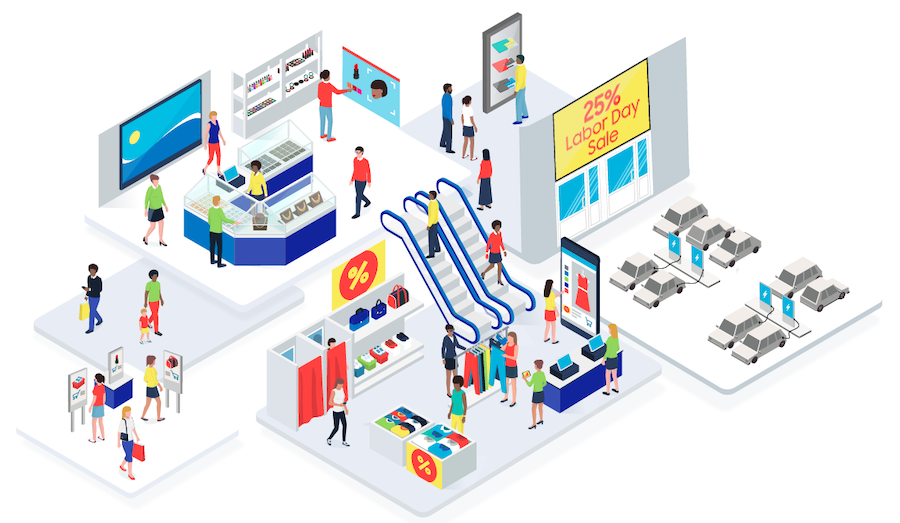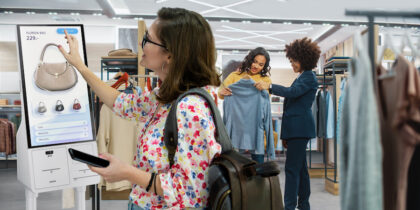Retailers faced an uphill battle against the proliferation of online shopping in recent years. Now, we see the pendulum swinging back toward in-store experiences as consumers seek to get out of the house and rediscover their favorite brands.
While physical retailers may have had to fight to stay relevant next to giants like Amazon and the rise of virtual brands, they now have a monumental opportunity to reinvent the in-store shopping experience and provide consumers with unique, engaging, sensory-laden experiences that you can’t get online.
There’s just one problem: These opportunities depend on modern digital capabilities — but retailers are skittish about investing in these new solutions. They worry that the ROI may not be worth it, and that “going digital” will disrupt operations and be too overwhelming to manage time-wise. While these are legitimate concerns, many retailers are not aware of the myriad of new, user-friendly tools available to them. Today’s software is much more intuitive and easier to navigate than it was in the past and provides an astounding amount of invaluable data that retailers can use to increase revenue and connect with consumers.
This article discusses four common myths about retail digital transformation — and the Samsung tools and partners that address them.
Myth #1: Retail digital transformation doesn’t work
Retailers love e-commerce because of the massive amount of consumer data they can acquire. It’s possible to see how users navigate to your site, how much time they spend there, which pages they view, how long it takes a customer to buy and what specific ads or marketing messages spur them to purchase.
But here’s what many retailers don’t know: You can access the same level of data about physical stores. Using Samsung displays and anonymous, RF-based (radio frequency) AI solutions from FastSensor, you can study and A/B test the full conversion funnel by knowing exactly how long people spend in the store, which in-store marketing messages convert and which don’t, how to optimize product placement and much, much more.
Shoppers travel through an online store using clicks and keystrokes, and their behaviors can be influenced by factors such as design and ad placement. Using FastSensor and MagicINFO, Samsung’s proprietary content management system (CMS), brands can monitor a potential buyer’s movements inside a physical store and adjust display content accordingly — just like on a website.
How digitizing retail experiences boosts ROI
Explore customer behavior with and the operational benefits of a complete digital retail ecosystem. Download Now
A convenience store, for instance, might have beverages on end caps with Samsung displays that feature images of a soda splashing over ice or the crack of a can opening. Retailers can then determine if the content on the displays encourages purchases, and if not, change it. FastSensor can provide deeper insights such as how many potential customers pass in front of a store, which zones they stay in longest, and how many customers ultimately convert, helping retailers build a complete connected journey. Treating your physical location like a website can help retailers better understand and maximize the impact of digital.
Myth #2: Retailers can’t produce enough content
A common refrain among retailers is that they won’t be able to produce enough content for in-store displays. This is actually one of the easier challenges to address, in the form of user-generated content (UGC). UGC is content that is created by individuals rather than by the brand itself, such as social media posts, reviews or unboxing videos. UGC is practically unlimited, free and, most importantly, it resonates with buyers, who love social proof.
Retailers can access UGC content with Sprinklr, a social listening tool that is built into Samsung’s system-on-chip (SoC) display architecture. A retailer can show social media posts that feature the brand in a positive light or access trend data to help shoppers discover new products. Brands can also showcase their own social feeds — both in-store and in corporate offices — that highlight employees, community engagement, sustainability initiatives, job openings and more. With Sprinklr, brands have access to an unlimited content cache that is fresh, authentic and original.
Myth #3: Managing digital signage and data takes too much time
Let’s be frank for a moment: Tech obsolescence is a major problem for retailers who bought into legacy systems that don’t play nice with modern retail software. It’s unrealistic for all but the biggest enterprise brands to completely overhaul all their digital offerings at once. That’s where Blueforce and MagicINFO come in.
Blueforce acts as a sensor and information system that bridges the tech obsolescence gap. It connects legacy technology investments, but also provides extensions that ensure that new best-in-class sensors and systems can be rapidly leveraged. Blueforce monitors these varied technologies to include FastSensor and other retail software, and “translates” data to the MagicINFO CMS. Then, it goes a step further, enabling “single pane of glass,” customized, easy-to-read data dashboards for viewers. These dashboards can compare content outcomes, provide SKU and sales data and even predict how factors such as weather and events might impact the business.
Myth #4: Retailers can’t afford a digital program
When it comes to digital transformation, price is always a consideration. While some initial investment is inevitable, there’s a way to offset these costs. Using the Samsung Ads platform, retailers can sell programmatic ads inside the store. Duty Free Americas (DFA), for example, showcases luxury items such as high-end fragrances and top-shelf spirits on Samsung QM and QH series displays inside its stores. Vendors pay a premium price to play their ads there — especially since, using flight arrival and departure data, they can target messaging to a specific demographic of people who they know will walk past DFA stores at a certain time. A spirits vendor might feature a video of a refreshing cocktail splashing over ice, while a cosmetics brand might highlight influencers or celebrity models.
The truth: Retail digital transformation is within reach
Treating your retail location like a website can bring shoppers the best of both worlds and offer new, exciting ways for customers to interact with your brand. And with Samsung’s ecosystem of hardware and software products, retailers can rest easy about ROI. As for price, operators can add services as they go with Samsung’s SoC technology, and even pay for the technology using programmatic advertising. With Samsung as a trusted partner, brands can work smarter, not harder, to achieve digital transformation greatness.
It’s easy to create safer and simpler shopping experiences with strategically placed digital signage. Discover new ways you can adapt your store signage to keep shoppers safe and maximize ROI. Or, explore Samsung’s range of innovative interactive displays with versatile business applications.








